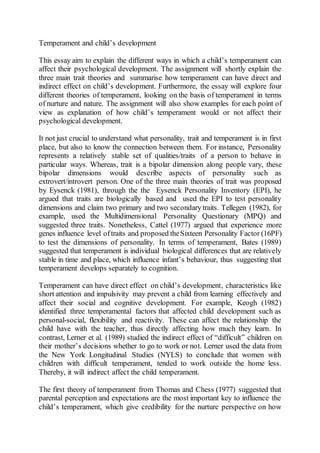
Temperament and child's development
- 1. Temperament and child’s development This essay aim to explain the different ways in which a child’s temperament can affect their psychological development. The assignment will shortly explain the three main trait theories and summarise how temperament can have direct and indirect effect on child’s development. Furthermore, the essay will explore four different theories of temperament, looking on the basis of temperament in terms of nurture and nature. The assignment will also show examples for each point of view as explanation of how child’s temperament would or not affect their psychological development. It not just crucial to understand what personality, trait and temperament is in first place, but also to know the connection between them. For instance, Personality represents a relatively stable set of qualities/traits of a person to behave in particular ways. Whereas, trait is a bipolar dimension along people vary, these bipolar dimensions would describe aspects of personality such as extrovert/introvert person. One of the three main theories of trait was proposed by Eysenck (1981), through the the Eysenck Personality Inventory (EPI), he argued that traits are biologically based and used the EPI to test personality dimensions and claim two primary and two secondary traits. Tellegen (1982), for example, used the Multidimensional Personality Questionary (MPQ) and suggested three traits. Nonetheless, Cattel (1977) argued that experience more genes influence level oftraits and proposed theSixteen Personality Factor (16PF) to test the dimensions of personality. In terms of temperament, Bates (1989) suggested that temperament is individual biological differences that are relatively stable in time and place, which influence infant’s behaviour, thus suggesting that temperament develops separately to cognition. Temperament can have direct effect on child’s development, characteristics like short attention and impulsivity may prevent a child from learning effectively and affect their social and cognitive development. For example, Keogh (1982) identified three temperamental factors that affected child development such as personal-social, flexibility and reactivity. These can affect the relationship the child have with the teacher, thus directly affecting how much they learn. In contrast, Lerner et al. (1989) studied the indirect effect of “difficult” children on their mother’s decisions whether to go to work or not. Lerner used the data from the New York Longitudinal Studies (NYLS) to conclude that women with children with difficult temperament, tended to work outside the home less. Thereby, it will indirect affect the child temperament. The first theory of temperament from Thomas and Chess (1977) suggested that parental perception and expectations are the most important key to influence the child’s temperament, which give credibility for the nurture perspective on how
- 2. child’s temperament can affect their psychological development. For instance, the (NYLS) carried out by Thomas and Chess, suggests that there are nine different dimensions of temperament. The aim of the NYLS was to described temperament from infancy to adolescence. Also, through the study they found that children rated high or low on some characteristics, were more likely to show the same characteristics at some point later in life. In contrast, Buss and Plomim (1984) argued that temperament is genetic based. They believe these dimensions are closely linked to adult personality traits. They proposed the Emotionality/Activity/Sociability (EAS) framework to study temperament. It was a lab studies and questionary analyses which showed only three dimensions of temperament. The aim of this study was to identify personality traits that emerged early in childhood considering that it might be genetic as they believed these most strongly would affect adult personality. On the other hand, Kagan (1988) argued that temperament is genetic but can be changed thought conscious effort, which suggests the child’s temperament is based on nature but can be shaped by nurture. He believes that children’s temperament can be sorted into discrete categories or temperament types. To prove his idea, Kagan developed the behavioural inhibition study. The inhibition to the unfamiliar according to Kagan, is the stage that the baby riches by the end of the first year of life, when infants are able to resist their tendency to approach the unfamiliar. The results showed that about 15% ofthe children of2-3 y.o. were shy, about 15% were talkative and approximately 75% of these children individual differences were stable into middle age. Therefore, this supports Kagan idea that, despite temperament is genetic, it can be changed by environmental experiences. Moreover, Dunn and Kendrick (1982) would say that genes are not the only influence on temperament, the social context is also critical on child’s temperament and how it can affect their temperament. They suggested that the child’s behaviour depends on the social context around them. For example, how a child’s mother behaves towards a child could influence they temperament at that moment. They say that children will showstable, consistentbehaviour styles in their interactions with other people, and if the child relationship with someone is stable when they are with that person, their temperament will also be stable when they are with that person. As a conclusion about how child’s temperament can affect their psychological development can be said that all the four different points of view proved their idea, however seems that nature and nurture would play different roles on child’s temperament. And despite that the four theorists disagree in terms of what causes these individual dimension such as biological argument from Buss and Plomin
- 3. based on Eysenck Nativist perspective, they all agree about the existence of environmental factors on child’s psychological development, which could lead psychologists on new research. Luciano Souza BSc Psychology Student June, 2015.
